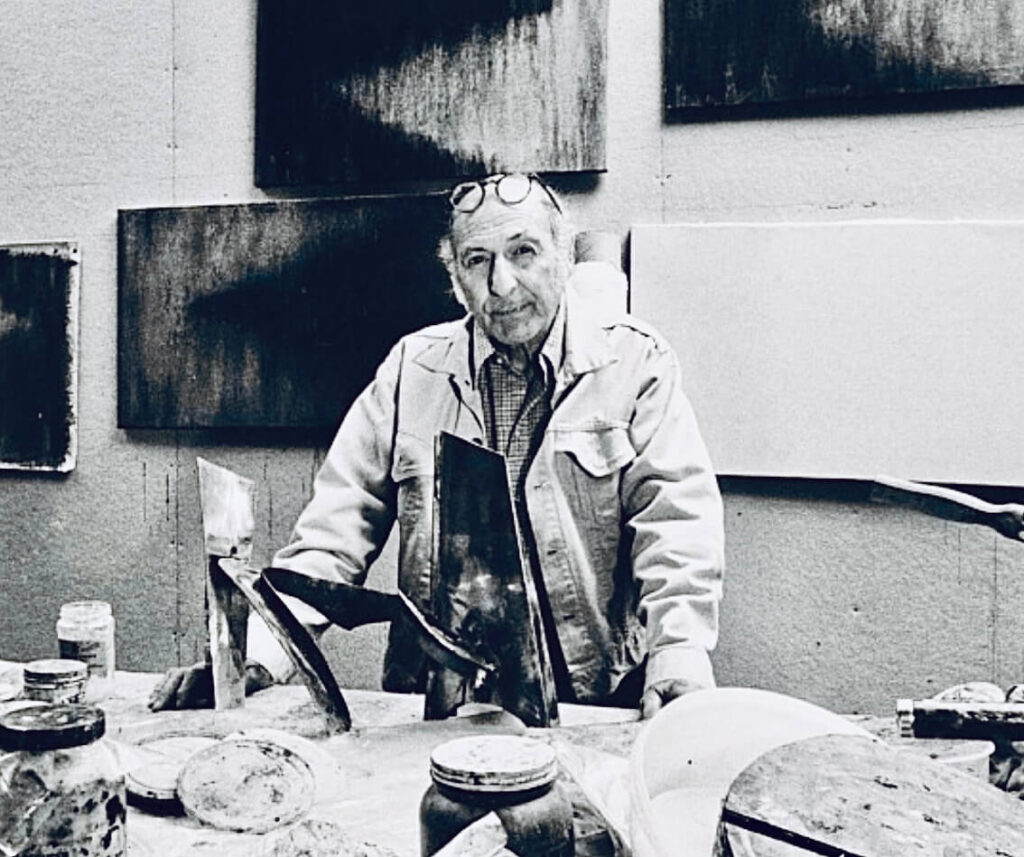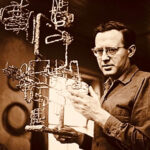Herbert Ferber
Herbert Ferber (1906-1991) was an influential American sculptor and painter whose innovative work helped to shape the course of 20th-century art. Known for his dynamic, abstract sculptures and his explorations of space and form, Ferber’s contributions to modern art are significant. This biography will delve into his life, career, and one of his most important artworks, illustrating his lasting impact on the art world.

Early Life and Education
Herbert Ferber Silvers was born on April 30, 1906, in New York City to Russian-Jewish immigrants. Growing up in Manhattan’s Upper East Side, Ferber was exposed to art and culture from a young age. Despite his early interest in art, he initially pursued a more conventional career path.
Ferber attended City College of New York, where he graduated with a degree in dentistry in 1927. He continued his dental studies at Columbia University, earning his Doctor of Dental Surgery (DDS) degree in 1930. Throughout his dental career, Ferber maintained his passion for art, attending evening classes at the Beaux-Arts Institute of Design and studying sculpture at the National Academy of Design.
Early Career and Transition to Art
Ferber practiced dentistry to support himself while pursuing his artistic ambitions. His early works were primarily influenced by classical and figurative sculpture. However, as he became more involved in the New York art scene, he was exposed to the burgeoning movements of Abstract Expressionism and Surrealism. These encounters had a profound impact on his artistic direction.
In the late 1930s, Ferber began to shift towards abstraction, exploring the possibilities of form and space. He became associated with the American Abstract Artists group, which included notable figures such as Josef Albers and Ad Reinhardt. This affiliation provided Ferber with a supportive community of like-minded artists and a platform to exhibit his work.
Breakthrough and Recognition
The 1940s marked a turning point in Ferber’s career as he began to gain recognition for his innovative approach to sculpture. His work during this period was characterized by an exploration of organic forms and dynamic compositions. Ferber often used materials such as wood, plaster, and stone, creating sculptures that were both abstract and evocative of natural forms.
In 1949, Ferber had his first solo exhibition at the Willard Gallery in New York City. The show was well-received, and his work began to attract the attention of critics and collectors. One of his notable early works, “The Second Man” (1949), exemplifies his interest in merging abstraction with elements of human form. The sculpture, made of carved wood, features a complex interplay of curves and angles, creating a sense of movement and tension.
Important Artwork: “Jackson Pollock” (1962)
One of Herbert Ferber’s most significant and acclaimed works is “Jackson Pollock” (1962), a sculpture that stands as a tribute to his friend and fellow artist.
“Jackson Pollock” (1962)
“Jackson Pollock” is a large-scale bronze sculpture that captures the dynamic energy and innovative spirit of the legendary Abstract Expressionist painter. The piece is notable for its intricate forms and the sense of movement that it conveys. Standing over six feet tall, the sculpture features a series of intertwining and overlapping shapes that seem to defy gravity.
The composition of “Jackson Pollock” is both complex and harmonious, with various elements interacting in a balanced yet dynamic arrangement. The sculpture’s bold lines and intricate forms convey a sense of energy and motion, reflecting Ferber’s ability to translate Pollock’s characteristic drip paintings into a three-dimensional form. The use of bronze, with its rich patina and varied textures, adds depth and complexity to the work.
“Jackson Pollock” is significant not only for its artistic merits but also for its broader cultural implications. Created in the years following Pollock’s untimely death in 1956, the sculpture serves as a tribute to the painter’s legacy and his impact on the art world. It embodies a celebration of Pollock’s contributions to Abstract Expressionism, while also acknowledging the sense of loss felt by his contemporaries.
Mid-Career and Continued Innovation
Throughout the 1950s and 1960s, Ferber continued to refine his technique and expand his artistic repertoire. He began experimenting with new materials, including welded steel and aluminum, incorporating them into his sculptures to create new visual effects. His works from this period are characterized by their increased scale and complexity, as well as their exploration of new textures and forms.
In the 1950s, Ferber began creating large-scale public sculptures and architectural commissions, such as “Roof Structure” (1950) at the Dallas Museum of Fine Arts and “Zim Zum I” (1969) at the University of Michigan. These works often incorporated a variety of materials, including metal, glass, and concrete, and were notable for their integration of art and architecture.
Ferber’s contributions to contemporary sculpture were increasingly recognized during his lifetime. He received numerous awards and honors, including a Guggenheim Fellowship in 1950 and a National Endowment for the Arts grant in 1970. His works were exhibited in major museums and galleries around the world, and he participated in important group shows such as the Venice Biennale.
Personal Life and Philosophy
Herbert Ferber’s personal life was marked by his dedication to his art and his passion for experimentation. He maintained a studio in New York City for much of his career but also spent significant time working in other locations, including his summer home in the Berkshires. His love for technology and engineering extended beyond his sculptures; he was an avid inventor and held several patents for his innovative designs.
Ferber’s artistic philosophy was rooted in a belief in the transformative power of art. He viewed his sculptures as a way to challenge conventional perceptions and to reveal new possibilities within everyday materials. This approach is evident in the vitality and dynamism of his works, which continue to captivate and inspire viewers.
Despite facing periods of financial difficulty and critical indifference, Ferber remained committed to his artistic vision. His perseverance and dedication to his craft are reflected in the body of work he created, which stands as a testament to his talent and his belief in the importance of art.
Legacy and Influence
Herbert Ferber’s legacy as a sculptor lies in his ability to transform industrial materials into vibrant and expressive works of art. His innovative use of metal and other materials helped to redefine the possibilities of sculpture, challenging traditional boundaries and opening up new avenues for artistic expression.
Ferber’s influence can be seen in the works of subsequent generations of artists who have been inspired by his inventive approach and his emphasis on materiality. His sculptures, with their combination of abstraction and representation, continue to resonate with viewers and artists alike, reminding us of the potential for creativity and transformation in the everyday world.
Later Works and Continued Innovation
In the later years of his career, Ferber continued to experiment with new materials and techniques, creating works that expanded the boundaries of his practice. He revisited earlier themes and forms, often incorporating elements from his previous works into new compositions. This period saw the creation of large-scale installations and public sculptures, such as “Golden Day” (1983) and “Altar Piece” (1985), which further solidified his reputation as a leading figure in contemporary art.
Ferber’s later works also reflected his ongoing engagement with color and form. He often used brightly colored, industrially coated metals, which added a sense of vibrancy and immediacy to his sculptures. His ability to balance spontaneity with control, and to create order from chaos, remained a hallmark of his work throughout his career.
Death and Posthumous Recognition
Herbert Ferber passed away on August 20, 1991, in North Egremont, Massachusetts, leaving behind a rich legacy of artistic innovation and creativity. His contributions to contemporary sculpture have been widely recognized, and his works are included in the collections of major museums and galleries around the world, including the Museum of Modern Art in New York, the Whitney Museum of American Art, and the Smithsonian American Art Museum in Washington, D.C.
Since his death, Ferber’s work has continued to be celebrated through numerous exhibitions and retrospectives. His influence on contemporary art remains significant, and his sculptures continue to inspire new generations of artists and viewers.
Conclusion
Herbert Ferber’s artistic journey is a testament to his creativity, resilience, and profound understanding of form and material. Through his innovative approach to sculpture, he created a body of work that continues to inspire and challenge viewers. “Jackson Pollock,” one of his most important works, exemplifies his ability to convey complex ideas and emotions through abstract forms and dynamic compositions. Ferber’s legacy as a sculptor is a reminder of the transformative power of art and the enduring impact of creative vision.



